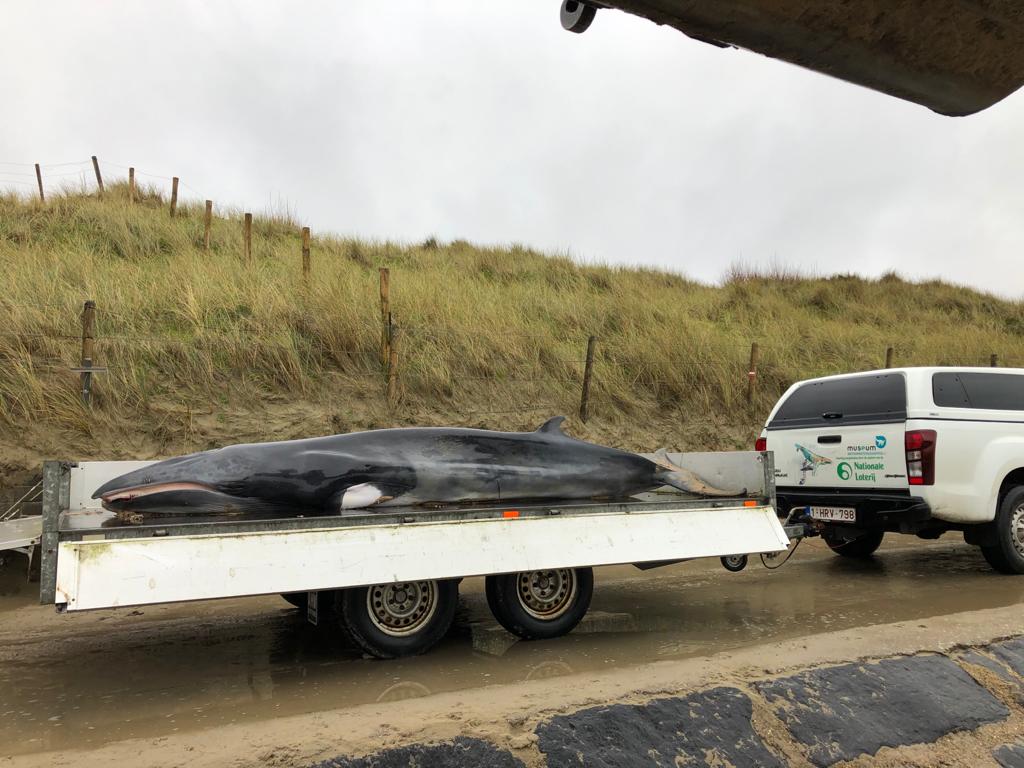Een jonge dwergvinvis die op 11 december aanspoelde op het strand van Bredene bleek een wel heel onfortuinlijke voorgeschiedenis te hebben: een lege maag, ingewanden vol parasieten en een afwijkende wervelkolom. Tot overmaat van ramp kwamen hier nog twee gebroken onderkaken bovenop. Het is pas de achtste dwergvinvis die tijdens de voorbije 20 jaren in België werd gedocumenteerd, en slechts de derde stranding.
In de voormiddag van donderdag 11 december 2020 spoelde op het strand van Bredene, nabij de grens met Oostende, het verse kadaver van een jonge dwergvinvis (Balaenoptera acutorostrata) aan. Het dier van 3,89 m lang (een volwassen dwergvinvis kan bijna 10 m lang worden) en 489 kg zwaar oogde zeer mager, en had een gebroken rechteronderkaak waarvan de beenderen doorheen de wonde naar buiten staken. Een gezond exemplaar van de lengte van het Bredense dier zou ongeveer het dubbele moeten wegen, dus werd meteen vermoed dat het ook zonder breuken reeds in een slechte gezondheidstoestand vertoefde.

Autopsie legt doodsoorza(a)k(en) bloot
Het kadaver werd onmiddellijk overgebracht naar de faculteit Diergeneeskunde van de UGent, waar een team van de UGent en de ULiège op 12 december een autopsie uitvoerde. Dit post-mortem onderzoek bevestigde de lamentabele toestand van de onfortuinlijke dwergvinvis: in de maag werden geen resten van een recente maaltijd aangetroffen, het spijsverteringssysteem zat vol parasieten en de wervelkolom vertoonde afwijkingen. De open breuk in de rechteronderkaak bleek minder oud dan eerst vermoed, en ook de linkeronderkaak bleek gebroken. Het vermageren stond uiteindelijk niet in relatie met de breuken: die moet het dier pas heel recent opgelopen, en waren het gevolg van een botsing met een obstakel zoals een vaartuig of strandhoofd, of met de zeebodem.

Dwergvinvissen in België
Hoewel de dwergvinvis deel uitmaakt van de Noordzeefauna, is zijn verspreidingsgebied hoofdzakelijk beperkt tot het noordelijke en centrale deel van de Noordzee. De laatste jaren blijken ze echter wat vaker zuidelijker op te duiken, vermoedelijk door veranderingen in het mariene ecosysteem. “Uit de Belgische wateren waren ons uit de laatste 20 jaar slechts zeven aangetoonde gevallen bekend, waarbij het drie keer om kadavers en vier keer om waarnemingen van levende exemplaren ging.” verduidelijkt Jan Haelters, expert zeezoogdieren aan het KBIN. “De kadavers dateren uit 2004 (dood aangetroffen op zee en aan land gebracht; gestorven door bijvangst), 2013 (stranding; gestorven door inslikken van een grote hoeveelheid plastic) en 2017 (kadaver in staat van ontbinding op zee). De levende dwergvinvissen werden opgemerkt in 2013, 2017, 2019 en 2020.” Van enkele meldingen uit oktober 2020 is niet met zekerheid bekend of het om dwergvinvissen ging.

Het skelet van de Bredense Dwergvinvis zal worden behouden voor de wetenschap.
